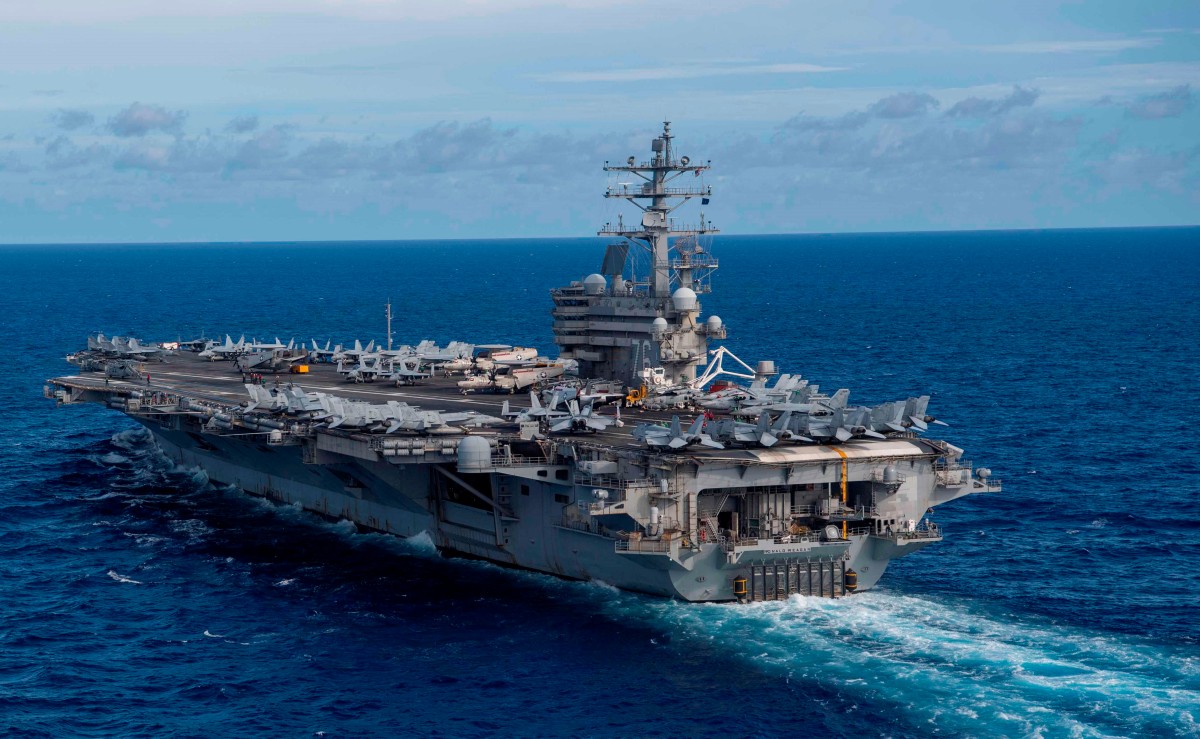The USS Ronald Reagan, the US Navy’s aircraft carrier, bid farewell to its Japanese home port on May 16, concluding a remarkable nine-year deployment in the Indo-Pacific.
US, Japan Sign Deal To Develop Hypersonic Interceptor To Counter Chinese, Russian, N.Korean Threats
The carrier has played a pivotal role in bolstering security in the region by strengthening defense ties between the United States and its regional partners.
Hundreds of naval personnel stood along the ship’s rails, with some on the flight deck organizing themselves to create the Japanese farewell phrase “dewa mata,” meaning “see you.” Two guided-missile destroyers, namely the USS Robert Smalls and USS Howard, accompanied the carrier on its journey.
With the departure of the USS Ronald Reagan, its service in Japan draws to a close, marking the end of an era. Later this year, the warship is slated to be replaced by the USS George Washington, another powerful Nimitz-class carrier.
According to US Ambassador to Japan Rahm Emanuel, the carrier’s departure comes after a tenure marked by over 400,000 nautical miles traversed, eight deployments, and numerous multinational exercises.
After nearly a decade in Japan, more than 400,000 nautical miles, eight deployments, and dozens of multinational exercises, the USS Ronald Reagan departs Japan for one final deployment before returning home 🇺🇸. Thank you to the Japanese people for being such gracious hosts and… pic.twitter.com/A4oCkD4HUJ
— ラーム・エマニュエル駐日米国大使 (@USAmbJapan) May 16, 2024
“Thank you to the Japanese people for being such gracious hosts and to the 6,000 crew for protecting peace and safeguarding security in the #IndoPacific. Fair winds and following seas,” Ambassador Emanuel expressed his gratitude on X (Formerly Twitter).
“For the past nine years, the USS Ronald Reagan and her crew have ensured that millions of people across the Indo-Pacific have been able to live their lives free of coercion, aggression, and suppression,” Emanuel added.
The ambassador also noted, “High ideals on the high seas. The USS Ronald Reagan, named after a president who won the Cold War in defense of democracy and freedom, will be replaced in Japan by the USS George Washington, named after a president who won the Revolutionary War in pursuit of independence and political freedom.”
Since it arrived in Yokosuka in 2015, the USS Ronald Reagan has been the vanguard of Carrier Strike Group 5, serving as the Navy’s sole aircraft carrier stationed overseas.
Rear Adm. Gregory Newkirk, strike group commander, highlighted the symbolic significance of the carrier’s presence in the region, describing its role as a tangible representation of America’s commitment to its allies in the Indo-Pacific.
“I cannot emphasize enough how much we, and the world, benefit from the incredible strength of our US-Japan alliance,” Rear Adm. Newkirk remarked from the carrier’s flight deck.
USS Ronald Reagan Once Closely Tracked by A Chinese Submarine
As the USS Ronald Reagan bids farewell to its Japanese home port, its departure is a poignant reminder of the geopolitical tensions that have characterized its operational tenure in the Indo-Pacific region.
Throughout its nearly nine years of service, the aircraft carrier has been at the forefront of deterrence efforts against China’s assertive posture, engaging in numerous missions to safeguard regional stability.
One of the most notable incidents involving the USS Ronald Reagan occurred several years ago when a Chinese submarine was reported to have tracked the supercarrier in the waters of Japan.
In 2015, US defense officials confirmed that a Chinese Kilo-class submarine closely shadowed the USS Ronald Reagan, which had recently assumed its role as the flagship of Carrier Strike Group 5 in Yokosuka, Japan.
During this encounter, the submerged Chinese submarine trailed the USS Ronald Reagan for at least half a day, reminiscent of Cold War-era confrontations between American and Soviet naval forces.

However, experts downplayed the significance of the incident, emphasizing that such encounters serve as opportunities to assess and understand the capabilities of potential adversaries.
Robert Daly, then-director of the Kissinger Institute on China at the Woodrow Wilson Center, said that the USS Ronald Reagan was not attempting to conceal its movements or evade detection during the operation.
Instead, it represented a routine demonstration of naval capabilities and readiness in the region. “The truth is, we track them tracking us, and we learn about their capabilities,” said Robert Daly.
Furthermore, just days after the encounter with the Chinese submarine, the USS Ronald Reagan faced another challenge when two Russian Tupolev Tu-142 aircraft flew within one mile of the carrier at a low altitude.
The maritime reconnaissance and anti-submarine warfare planes prompted the USS Ronald Reagan to scramble four armed F/A-18 Hornets for interception, underscoring the complex dynamics of maritime security in the region.
While these incidents may have been overshadowed by the broader strategic landscape at the time, they serve as reminders of the ongoing competition and vigilance in the Indo-Pacific theater.
- Contact the author at ashishmichel(at)gmail.com
- Follow EurAsian Times on Google News




